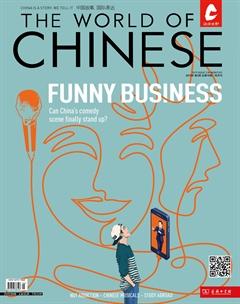Tough Nut to Crack
Hatty Liu

Chinas popular binglang snack is part carcinogen, part cultural heritage.
檳榔:是文化遗产还是健康隐患?
There is a muscle, three centimeters wide, that protrudes from Mr. Gus left jaw as he speaks. When he swallows or pauses to think, it retreats into the side of his cheek, but returns almost immediately as he picks up his tale.
The muscle is just the right size to hold a half-slice of binglang, the psychoactive nut that the 60-year-old motor-cab driver almost never stops crunching during the day, just as he never stops praising its health benefits. “Ive been chewing since I was 8 or 9 years old…and my blood circulation is excellent. Theres never been anything wrong with my health in my life,” Gu brags with a red-stained smile, “except that most of my teeth have been worn down.”
Binglang, which grows from the areca palm, is a fruit of contradictions. Though often called “betel nut” in English, its technically a berry rather than a nut, and unrelated to the betel vine—thats the plant whose leaf produces the red saliva when eaten along with the fresh green nut (along with a generous slathering of slaked lime, tobacco, and other flavorings) as a snack known as “betel quid” throughout South and Southeast Asia. In Hainan, Chinas southernmost province, locals like Gu swear by binglangs alleged medicinal properties, which include everything from stimulant to aphrodisiac to digestive aid, yet a 2017 research paper by the US National Cancer Institute declared it a “neglected global public health emergency.”
The effect of biting into binglang has been compared by fans to drinking six cups of coffee, giving the eater an initial dizzying rush of euphoria, followed by a feeling of warmth and a heightened level of alertness. Critics, though, say its more like smoking three cigarettes, or chewing a handful of tobacco. The World Health Organization classifies the areca nut as the fourth-most addictive substance in the world, after caffeine, alcohol, and tobacco, and both the nut and betel quid as carcinogens linked with higher rates of oral, stomach, and liver cancer. In Hunan, the PRCs other major binglang-chewing province, oral cancer rates are “significantly higher than the national average” according to a 2018 statement by the provincial Office of Cancer Research and Prevention.
Domestic exposés are accordingly on the rise, most notoriously Shenzhen TVs Men with Cut Faces in the Binglang Kingdom, a 2013 documentary that featured graphic images of lifelong areca-eaters in Hunan with parts of their cheek or tongue removed and reconstructed due to cancer, as well as consumers with flesh-eating tumors, stained and cracked teeth, abrasions inside their mouth, and holes in their cheek. The same year, CCTVs News 30 program explored the nuts cancer risks, and in 2017, the China Food and Drug Administration translated and republished the WHOs list of cancer-inducing substances on its website, areca among them.
These criticisms are proving tough to swallow for the communities already deeply dependent on binglang—both as a business and culture. “Every three to five years, theres a controversy, an attempt to smear binglang,” declares Peng Shangwen, general manager of Hainans Yali Agricultural Development Company, a dried-binglang manufacturer which hosts the recently opened Wanning Municipal Areca Museum on its campus.
The museum is “a joint project by our company, the Wanning Binglang Bureau, and the city government, that uses artifacts associated with binglang to showcase Hainans agricultural heritage, culinary heritage, folk heritage, literary significance, and inheritance from its ancestors,” Peng explains to TWOC.
Similarly, last year, the Hunan Binglang Industry Association applied for “intangible cultural heritage” status for its provincial “binglang culture,” already a municipal heritage item in the city of Xiangtan since 2007. In March, the same association banned local binglang enterprises from advertising their products nationwide, raising the hopes of some anti-binglang activists, until president Yang Xun clarified to Xinhua News Agency that they simply wanted to “standardize” competition: “Its not because binglang causes cancer like everyone thinks.”
“Binglang cultivation goes back thousands of years, and its only in the last 20 years that people have been saying [critical] things,” Peng says. “Im not going to comment on those, only that, with 2 million people involved in binglang cultivation in Hainan, any attempt to say its cancerous is going to be taken as a criticism of the locals themselves.”
Out on the streets of Changfeng, the town outside Wanning where Yali is headquartered, Ms. Fu, the owner of a dry-goods store near where Gu parks his motorbike, is venting against what she perceives as media busybodies bent on destroying local industry.
“Look at all these people around you, whove eaten binglang all their lives. Does anyone have cancer? Is anyone dead?” Fu rails. “Its all lies! They keep coming around to say binglang is bad for you, so who will buy from our farmers anymore? It will be a disaster!”
“We have nothing else of value here,” Fu insists to TWOC. “If you take away binglang, then Hainan wouldnt have any special characteristics left.”
Binglang has been associated with Hainan since the 12th century, though it has been consumed locally for much longer. The areca palm has been cultivated across Southeast Asia and the Pacific for several millennia, and the method of eating the nut with the betel leaf may have emerged in the Philippines 4,000 years ago. By the Northern and Southern Dynasties period, it had already appeared on the Chinese mainland as a tribute item for the emperor, but was not yet widely consumed.

